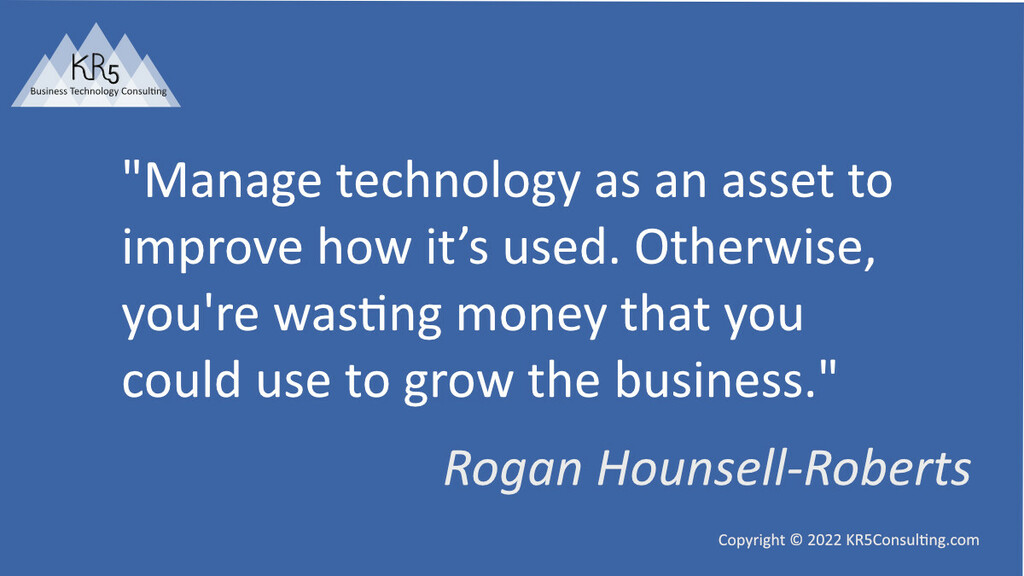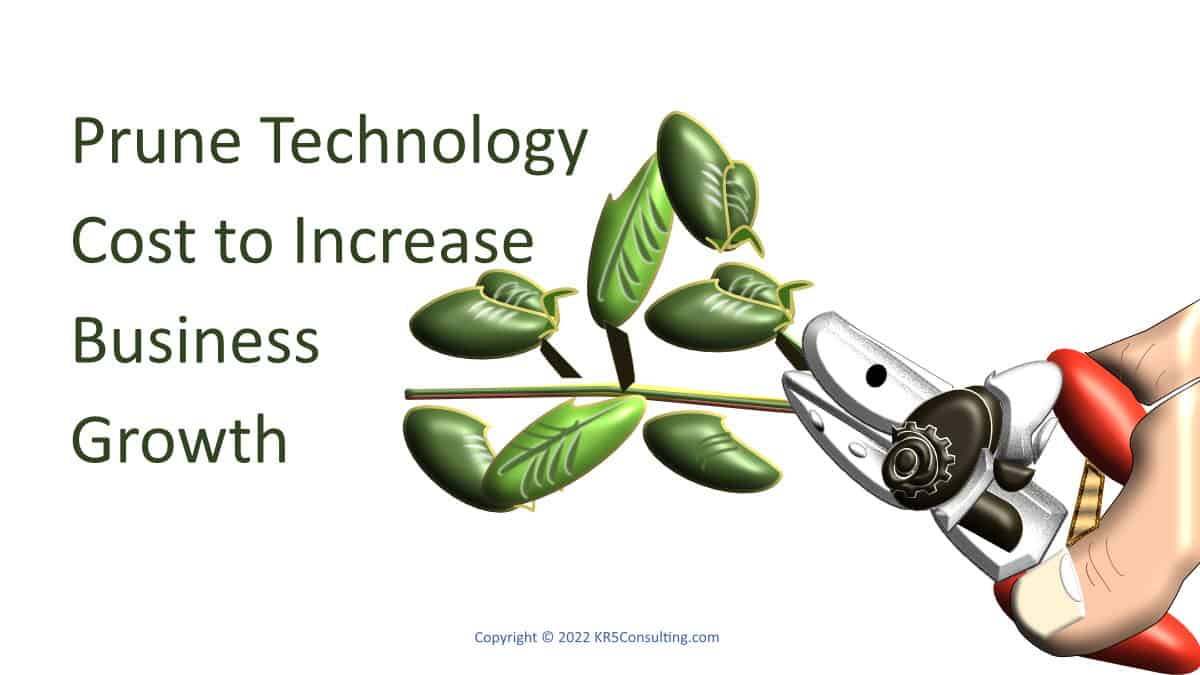Entrepreneurs battling with finances can see technology as a big expense and an area to reduce cost. Without an endless pot of money, they want to be smarter and make their money go further. In contrast, technology is a key to growth and vital for lowering costs. So, does it make sense to reduce cost here, or should leaders go the other way and invest more?
If you want faster growth and a smart approach to managing technology cost, then this article is for you.
There’s a strong link between IT spend and revenue growth, according to Frost and Sullivan. Almost half of those surveyed that had more than 30% growth, invested more than 15% of their revenues into IT. Yet in the UK, we waste a quarter of software spend on average (IE, 2016). And small businesses waste even more than that!
Growth needs money, so cash that’s wasted will hold you back. In this article we’ll look at IT spend with a critical eye, so you use your time and money more effectively.
Many struggle with getting the best of out of technology. Our guide, Business Technology: Essential Guide to Best Use, will help you create a robust process to ensure your new tech achieves your aims.
What is Technology Cost?
Technology cost is the cost for the whole solution. It’s the cost of buying or building, as well as getting it running and keeping it running. That means that if you want to reduce technology cost, you need looking beyond yearly fees. For example:
- Design & build costs which are typically a one off but could be ongoing.
- Licence or subscription cost.
- Maintenance cost which are usually 20% of purchase cost.
- Customisation of an app to make it work in your business.
- Training which you may need to repeat.
- Cost of laptops and other kit.
- Cost of support and maintenance for kit.
But that’s not the only cost to consider. There’s an opportunity cost too.
Technology Opportunity Cost
Technology opportunity cost is the time or money spent that you could have, instead, used for greater benefit. That’s important to consider for reducing technology cost.
In part that’s about spending time or money on the right things. That’s to say, the benefit gained justifies the spend.
The other part is about using something that’s slow and outdated. You’re spending too much time staring at a screen instead of getting other (more important) things done.
As an aside, when buying you’d look at the lost opportunity cost of not having technology. After all, tech allows you to do so much more, and do things that aren’t possible without it!

How is Technology Cost Effective?
Technology is cost effective if it reduces cost or if it fuels growth. For example:
- Increases productivity so you can get more done. Therefore, you could help more customers without taking on more people.
- Reduces how long it takes to get things done. That could make customers happier and fuel growth. Or it could mean you’re tying up less cash in your inventory.
- Reduce the cost of doing business. For example, sales through ecommerce.
- Better information so you can make better and faster decisions.
Yet, if it’s not paying its way, how can we cut back costs?
Six Ways to Cut Costs
You don’t want to reduce technology cost if that hurts the business. Yet you don’t want to be one of those businesses that wastes a quarter of their IT spend. So, how do you tackle waste?
Are you still using it?
Stop paying for stuff you’re not using. If you’re not using something, and you don’t plan to use it in the near future, it’ll save money and won’t hurt the business. And don’t forget to check your user licences or seats too. You might be paying for more than you’re using!
Can you reduce overlaps and duplication?
Consolidate overlapping apps and retire ones you don’t need anymore. This is how it happens. You buy something to solve a problem. Later you buy another solution with more umph to solve a different problem. The new solution can solve both problems, but you continue using both. In this instance save money, move both to use the new solution, and retire the old one.
Get rid of duplicate apps and merge them into one. If you grow by buying other businesses, you’ll end up with duplicate systems. You can also get duplicates if you never fully migrate old apps because the old app can do this one thing that the new one doesn’t. It’s a tough decision, but sometimes you need to take it and migrate to one system that will do it all.
Is there a better product?
Replace an out-of-date solution with one that offers better value. Technology prices tend to fall with time. Newer apps are often better value for money. When built with the latest technology, they’re often easier to use and have more features. That’s a fantastic way to reduce technology cost.
Could you make better use of what you’ve got?
Avoid buying something new by using what you’ve got. Are there unused features that you’ve bought but don’t use? Vendors often supply increasing features to create a more valuable app. If you bought an app for one problem, you might have untapped potential. If it doesn’t do quite what you need it to do and you’re in no hurry, you might find the vendor open to an enhancement request.
Could the business work better?
Transform the way you work to make better use of your resources. Sometimes the way we do things is behind the times and needs an overhaul. In this case, it often uses tools that become obsolete when you take a fresh approach.
Could your technology work better together?
Reduce the cost of apps working together using a standard way to connect them. Getting two apps to share information can be costly. In the worst case, it’s someone putting the same information into both systems. In other cases, you can have custom code that does it for you, and you have to pay for building that, and pay for updates! Choosing technology that includes vendor adapters or has a standard way to hook up with other apps can save both hassle and cost.
Taking a Smarter Approach to Managing Technology
Manage technology as an asset to improve how it’s used. Otherwise, you’re wasting money that you could use to grow the business. We’re all better with something we can see, and software is less tangible. As a result of it being out of sight, we can overlook the cost of waste. There are two simple steps to improve how you use technology in the business. Firstly, create a list of technology used along with spend. Secondly, audit its usage to make sure you’re making best use of your assets.
Summary
Investing in technology is a key to growth and reducing cost, yet we waste a quarter of our yearly spend. The cost is more than annual fees. It’s also the cost of kit, training, and opportunity cost. Because apps are less tangible, it’s easy to lose control of what you’ve got. Thinking of your technology as assets helps you take control and spend wisely.
Related Articles
Notes
- Frost and Sullivan (2019), Allocation of IT/Telecom Budget by Vertical Global 2019, Frost & Sullivan Online. https://ww2.frost.com/
- IE (2016), Software Usage and Waste Report 2016, https://www.1e.com/resource-center/the-real-cost-of-unused-software-2015/

